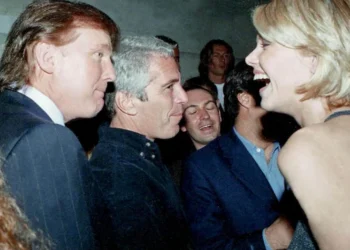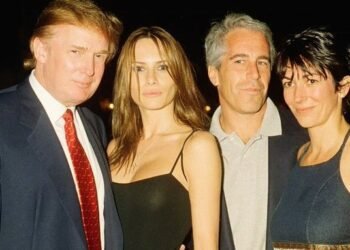President Trump’s aggressive tariff strategy, aiming to rectify trade imbalances and curb fentanyl trafficking, faces staunch opposition from China. The threat of additional tariff on Chinese goods sparks concerns of increased consumer costs and market disruptions, highlighting the potential for severe economic repercussions.”
BY PC Bureau
Beijing, April 8, 2025 – In a bold escalation of the ongoing US-China trade war, China has firmly rejected conditions set by US President Donald Trump to avert an additional 50 percent tariff on its goods. The announcement came late Monday, with Chinese officials declaring that Beijing would not bow to pressure or threats, signaling a deepening standoff between the world’s two largest economies.
Trump’s latest warning, issued on Monday, threatened the steep tariff hike if China did not retract its planned countermeasures to existing US trade policies.
In a statement on Truth Social on Monday morning, the US president said that China enacted the retaliatory tariffs despite his “warning that any country that Retaliates against the U.S. by issuing additional Tariffs” would be “immediately met with new and substantially higher Tariffs, over and above those initially set”.
“If China does not withdraw its 34% increase above their already long term trading abuses by tomorrow, April 8th, 2025, the United States will impose ADDITIONAL Tariffs on China of 50%, effective April 9th,” Trump wrote.
🚨Alert: Trade War heats up!! China REJECTS Trump’s additional 50% tariff threat! Threatens more attacks on the US economy!!
“Putting pressure on or threatening China NOT the right way to deal with us!”
– Chinese Foreign Ministry pic.twitter.com/g0mWYN9EIw— US Homeland Security News (@defense_civil25) April 7, 2025
The Chinese Ministry of Commerce urged the US to abandon its tariff strategy and engage in “equal dialogue” to resolve trade disputes, a call that appears unlikely to sway the Trump administration’s hardline stance.
On April 7, 2025, China’s Foreign Ministry spokesperson, Lin Jian, addressed the US tariff policy during a press briefing. According to a statement reported by China Daily and Xinhua News Agency, Lin Jian said:
“The United States is practicing hegemony under the guise of imposing so-called reciprocal tariffs, warning that such actions will inevitably face widespread opposition from the international community.”
(China Daily, April 7, 2025; Xinhua News Agency, April 7, 2025)
This was in response to Trump’s broader tariff strategy, including the reciprocal tariffs announced earlier in the week. The Foreign Ministry further stated:
“U.S. slapping of ‘reciprocal tariffs’ deprives countries, especially Global South, of right to development.”
(Xinhua News Agency, April 7, 2025)
On April 8, 2025, following Trump’s specific threat on April 7 of an additional 50 percent tariff (which would raise the total tariff on Chinese goods to 104 percent if implemented on April 9), China’s Ministry of Commerce issued a direct response. According to Xinhua News Agency at 06:43 AM IST on April 8, 2025:
“China will resolutely take countermeasures if U.S. escalates tariff measures.”
(Xinhua News Agency, April 8, 2025)
These statements reflects China’s immediate reaction to Trump’s latest escalation, emphasizing a firm intent to retaliate without specifying the exact countermeasures at that moment.
Trump’s Tariff Gambit
President Trump’s threat of an additional 50 percent tariff builds on an already aggressive trade policy. Since taking office in January 2025, Trump has imposed successive tariff increases on Chinese imports, including a 10 percent levy in February and another 10 percent in March, bringing the baseline tariff rate on Chinese goods to 54 percent as of April 9. The proposed 50 percent hike would push this rate to an unprecedented 104 percent on many products, a move Trump has framed as a response to China’s alleged failure to curb fentanyl trafficking and address trade imbalances.
Speaking from the White House on April 2—dubbed “Liberation Day” by the president—Trump signed an executive order imposing a minimum 10 percent tariff on all US imports, with higher rates of up to 50 percent targeting 57 nations, including China. “Other countries have used tariffs against us for decades, and now it’s our turn,” Trump declared, emphasizing his goal of rebalancing trade and protecting American industries.
US-China Trade Balance: A Persistent Divide
The US-China trade relationship has long been marked by a significant imbalance. In 2023, the US recorded a goods trade deficit with China of over $279 billion, according to the US Census Bureau, with imports from China totaling approximately $427 billion against exports of just $148 billion. This gap has fueled Trump’s rhetoric about “unfair” trade practices, including accusations of currency manipulation and intellectual property theft.
China, however, has reduced its reliance on the US market over the past decade. Trade as a share of China’s GDP has dropped from over 60 percent in the early 2000s to about 37 percent today, as Beijing has bolstered domestic production and expanded trade with partners like the European Union, Mexico, and Vietnam. Despite this shift, the US remains a critical market for Chinese exports, particularly in electronics, machinery, and consumer goods.
The Trump administration’s tariffs aim to narrow this deficit by making Chinese goods more expensive and encouraging American consumers and businesses to buy domestically. Yet, economic studies from Trump’s first term suggest that such measures often backfire, with US importers and consumers bearing the brunt of higher costs rather than China itself.
Impact of the Tariff War
The intensifying tariff war is already sending shockwaves through global markets and supply chains. On Friday, after China announced reciprocal 34 percent tariffs on all US imports effective April 10, US stock markets plummeted, with the S&P 500 dropping 9.08 percent for the week. Analysts warn that the proposed 50 percent tariff could exacerbate these disruptions, potentially shaving up to 2.5 percentage points off China’s economic growth this year, according to Macquarie Group economist Larry Hu.
For the US, the tariffs threaten to reignite inflation, a concern echoed by Federal Reserve Chair Jerome Powell, who noted last week that the measures were “larger than expected” and could elevate price pressures. Economists estimate that the current tariff regime could increase US household costs by nearly $1,000 annually, with further hikes likely to amplify this burden. Industries like electronics, toys, and agriculture—where China dominates US imports—face immediate price hikes, with toy industry experts predicting up to 50 percent increases for consumers.
ALSO READ: Young Kuki Slams Global Liangmai’s Claims in Land Dispute
China’s countermeasures, including export controls on rare-earth minerals and restrictions on US firms, could further strain American manufacturers reliant on these inputs. US farmers, already hit hard by earlier trade wars, face renewed losses as China targets agricultural exports like soybeans, wheat, and pork. During Trump’s first term, such retaliatory tariffs cost US farmers an estimated $27 billion in export sales, a precedent that looms large.
Global Ramifications and Uncertain Future
The standoff has broader implications for the global economy. The International Monetary Fund has warned that escalating trade barriers could reduce global GDP by as much as 1 percent, with developing nations particularly vulnerable to disrupted supply chains. Countries like Vietnam and Mexico, which have benefited from trade rerouting, may see short-term gains, but a prolonged conflict risks a worldwide recession, with J.P. Morgan estimating a 60 percent chance by year-end.
As both sides dig in, the prospect of negotiation appears dim. China’s refusal to yield suggests a calculated bet that its economy can weather the storm, while Trump’s unwavering commitment to tariffs reflects a belief that economic pressure will force concessions. For now, businesses and consumers on both sides of the Pacific brace for a turbulent road ahead, with the tariff war poised to reshape trade dynamics for years to come.
ALSO READ: Naga Students Demand AFSPA Repeal, Target Indian Army












